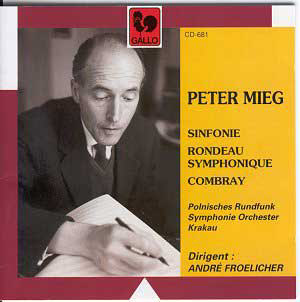Peter Mieg was born in Lenzburg, Switzerland. He studied
the arts broadly in Basel, Paris and Zurich in the 1950s and after advice
from Frank Martin he had some concert successes. His friendship with
artists in all spheres included Mr and Mrs Paul Sacher. Sacher commissioned
from him a work for string orchestra. Combray is the result.
The work is related to and inspired by Proust's ‘La recherche du temps
perdu’, a book which Mieg knew in minute detail. The three movements
are La salle à manger; La vivonne and Le Pré
Catelan. The music represents landscapes of the mind rather than
particular sound-pictures of places in the novels.
In Combray the first movement is lusty and singing
with touches of Tchaikovsky's Serenade for Strings in its swinging
motion. There are also references to Tchaikovsky's Fourth Symphony.
The second movement is again Tchaikovskian in Sérénade
Mélancolique mood. The Krakow orchestra's strings are not
up to snuff in the plushness department though adequate enough in tone.
There is a busy dancing finale - similar in feeling to Dag Wirén
in his Serenade for Strings or to Gösta Nystroem in his
two Concertos for Strings.
The Symphony is not neo-classical. Instead various
voices call for attention: Alwyn's Third Symphony (allegro comodo
at 5.23), Arnold Cooke and Vaughan Williams. The Martinù
influence raises its head in the little pecking motifs (e.g. 8.02 of
the first movement). As the movement progresses to its end it becomes
more dissonant but these things are comparative - gentle stuff really.
In the 'tempo di valse' we find modern echoes of Tchaikovsky 5 and of
the second movement of Number 4. The allegro is searchingly poignant
like a modern doppelgänger of the Tchaikovsky Pathétique
or the romantic Prokofiev 7. The Rondeau symphonique again reeks
of modernist Tchaikovsky (something of a Swiss counterpart to Boiko,
here) with a pleasing silvery violin dance at 6.40. The orchestra is
not ideally on song.
Rob Barnett


